
South Australian Medical Heritage Society Inc
Website for the Virtual Museum
Home
Coming meetings
Past meetings
About the Society
Main Galleries
Medicine
Surgery
Anaesthesia
X-rays
Hospitals,other organisations
Individuals of note
Small Galleries
Ethnic medicine
- Aboriginal
- Chinese
- Mediterran
SIR RUPERT MAGAREY
Kt.MB.BS.FRCS.(Eng.), MS, FRACS.,FRACGP.(Hon.)
1914-1990.
We are most grateful to his daughter Professor Susan Magarey AM, FASSA,PhD. for her suggestions and allowing us access to the documents and photographs relating to her father at the State Library of South Australia. She is also a founder of the Magarey Medal for Biography. We are also grateful to Mr.R. G. Johnson, MB.BS.(Adelaide), FRCS (Eng.),FRACS, MACLM, for his comments. Professor Simpson and Lt.Col. Sven Kuusk RFD provided valuable information and corrections.
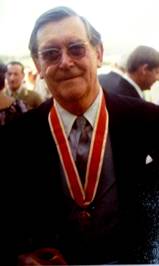
PHOTOGRAPH OF SIR JAMES RUPERT TAKEN AT HIS INVESTITURE AS KNIGHT BACHELOR (LONDON GAZETTE 31 DEC. 1979)
James Rupert Magarey, commonly known as Bob, was born in Adelaide on February 21st, 1914, the first of four sons and a daughter to Rupert Eric and Elsie Emily Cowell. The family was one of a group of settlers who arrived in Adelaide in the mid 1850s and became land owners near Naracoorte in South Australia. His great-great uncle was involved in football, became a noted administrator and was responsible for establishing the Magarey Medal in football.
Rupert attended Norwood Primary school and later St. Peter’s College, where in 1932 he was appointed Vice-Captain of the school and Captain of Boats. He was a son of a distinguished doctor and went to read Medicine at the University of Adelaide.
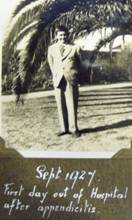 YOUNG MAGAREY AGED 13, RECOVERING AFTER APPENDICECTOMY. IT MAY BE THAT HIS EXPERIENCES INFLUENCED HIM TO SPECIALISE IN SURGERY
YOUNG MAGAREY AGED 13, RECOVERING AFTER APPENDICECTOMY. IT MAY BE THAT HIS EXPERIENCES INFLUENCED HIM TO SPECIALISE IN SURGERY
He boarded at St. Mark’s College and continued rowing for the University Intervarsity Crew and gained his blue. The crew won the 1934 Intervarsity race in record time.

PHOTOGRAPH OF THE UNIVERSITY VIII. J.R. MAGAREY SECOND ON THE RIGHT.

Like all other members of the crew he was given his oar with the crew-members’ names painted in gold. This spent many years on the bedroom wall of his son James. Later it inspired his grandson Matthew also a rower.
THE 1934 ADELAIDE UNIVERSITY ROWING TEAM AND MASCOT. BOB MAGAREY IS IN BACK ROW, 2ND FROM THE LEFT
Bob Magarey graduated MB. BS. in 1938. The Munich agreement was signed in September of that year and WWII broke out in 1939. Dr. Magarey was already serving in the 9th/23 rd Light Horse Regiment CMF, as a medical student but in 1940 he transferred to the AIF and his regiment became part of the 7 th Division of Australian Imperial Forces. The initial training was in Australia.
In April 1940 he married Catherine Mary Gilbert, but at the end of the year he sailed for the Middle East and Syria where he served in the 2/11 Australian Army General Hospital. In recognition of his distinguished services he was mentioned in dispatches, (Second Supplement to The London Gazette Friday, the 26 th of December 1941, page 7358).
After Japan entered the war Major Magarey’s unit was recalled to Australia and later transferred to New Guinea and the Kokoda Trail as part of the 2/6 Australian Field Ambulance.
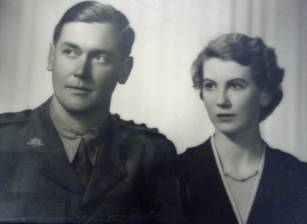
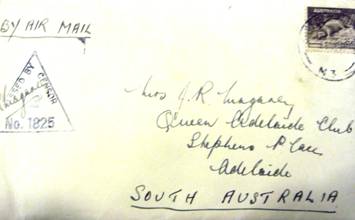
CAPTAIN MAGAREY AND HIS WIFE MARY ADDRESS ON THE LETTERS TO HIS WIFE (RIGHT)
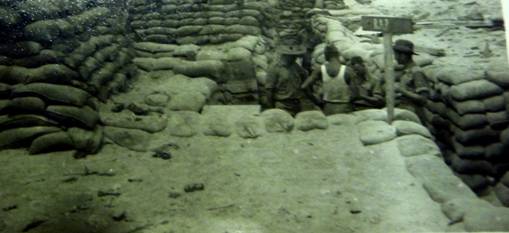
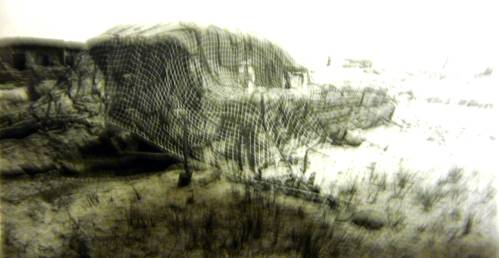
REGIMENTAL AID POST IN SYRIA (TOP) AND CAMOUFLAGE NETTING (BELOW)
The stay in the Middle East was fairly short. The threat of Japanese invasion became real and his Unit was recalled to Australia and later sent to New Guinea. Here Major Magarey served as Senior Medical officer at Alola on the Kokoda trail.


MAP OF KOKODA TRAIL AND THE ANKLE DEEP MUD ON THE TRAIL
Major Magarey’s signal contribution was the creation and establishment of an efficient evacuation route along the trail.
Alola had to be evacuated and important papers including his one of his diaries were destroyed. He rewrote his memories, noting : ”The result is that the report has been written very largely from memory and to a certain extent must inevitably be inaccurate. When doubt existed about times, numbers of patients, etc these have been omitted.” Signed J R Magarey Maj 2/6 Aust Fd Amb.
A valid advice to some autobiographers and recorders of events.
Raymond Paull in his book: ”Retreat from Kokoda” p117, wrote: “Throughout the fighting at Isurava and the jungle wilderness of the Kokoda Trail, Magarey’s personal inspiration and leadership and the devotion of his small band of personnel gave hope and fortitude to the wounded. The Australian Army had no greater men than these.”
J.R. Magarey writes of operating sometimes knee deep in mud and that for fatal injuries the only treatment was morphine. He recalls that the army issued stretchers were inadequate. The spreaders broke down and the canvas rotted. He records that the “fuzzy-wuzzy angels” were magnificent. The natives made their own stretchers, which were superior to the army models in transporting the wounded and supplies. He mentioned the early withdrawal and the confusion it caused. He also discussed the SIW (self inflicted wounds), malaria and diarrhoea problems. He stressed the importance of adequate supply lines and the value of new shoes and laces, blankets dressings and sulphonamides.
His next appointment was to the 2nd / 4th General Hospital in Brisbane. Later he went to active service as a senior surgeon at the 105 Australian Casualty Clearing Station in New Britain. He was discharged a few month after VJ day and returned to Adelaide.

THE MAGAREY RIBBON SHOWING THE “MID” (MENTIONED IN DISPATCHES) EMBLEM.
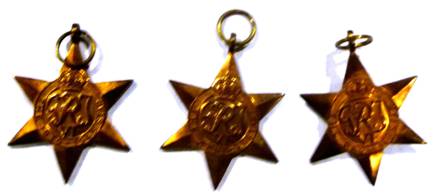
SERVICE MEDALS: LEFT TO RIGHT: 1939-1945 STAR, THE AFRICA STAR AND THE PACIFIC STAR.
Back in Adelaide he resumed his general practice in medicine. He was a General Surgeon with consulting rooms in the Verco Buildings on North Terrace and a member of the Honorary Staff of the Royal Adelaide Hospital (RAH). He and Mary and their first child Susan moved into a house at 14 Dutton Terrace, Medindie. James (Jum), Catherine (Bloss), and Mary Elizabeth (Beetle) were born later. In those days a surgical qualification was mandatory and Dr. Magarey went to England to obtain his FRCS in 1949 (Fellow of the Royal College of Surgeons of England). He returned to Adelaide and passed the FRACS in 1950 and an MS ( Master of Surgery) in 1951 from the Adelaide University.
He became an Honorary visiting Surgeon at the RAH and also a President of the Adelaide Medical Students Society. His lecture on “Wine Women and Weeds” was structured to reduce smoking, which he also gave up. When The Queen Elizabeth Hospital (TQEH) opened fully in1964, he became its foundation surgeon. He was an excellent teacher and students competed to be attached to his unit.
About this time he published a paper describing his experiences with choledocho-duodenestomy in the British Journal of Surgery called “Biliary Fenestration”. (Magarey J.R. Br. J. Surg. 53:41,1966.)
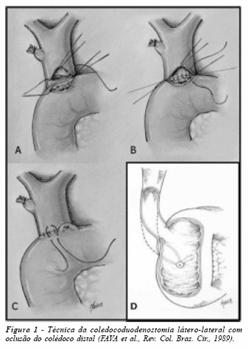
THIS DIAGRAMS SHOW THE JOIN BETWEEN THE COMMON BILE DUCT AND THE DUODENUM. THE ANASTOMOSIS LEAVES THE DISTANT DUCT IN PLACE AND IT FORMS A SUMP WHICH CAN CONTAIN GALLSTONES AND FOOD RESIDUE. THE PRESENCE OF THESE FOREIGN BODIES CAN LEAD TO INFECTION LATER.
J.R. Magarey’s procedure was easy to perform and most suitable for patients with severe anaesthetic risk and low life expectation. It received more than 150 citations sometimes negative. Progress usually changes management. The introduction of fibro-optic endoscopy and sphincterotomy some 20 years later is now the accepted form of first line treatment for retained gallstones after cholecystectomy.
Bob Magarey was also active in many hospital and teaching committees. He represented the surgeons on the Executive Committees of the RAH and later (1962) TQEH. He was a member of the Medical Curriculum Committee and travelled to the US on the Harkness scholarship to look at curriculum teaching and surgical techniques. He did not neglect his Surgical College (FRACS) duties and became a Council member and a member of the Court of Examiners.
In 1968 he followed his father’s medical career and became the president of the South Australian branch of the AMA. Presidency of the national body followed in 1976. He has been most active in the transition of the old honorary system to current system of paid visiting medical specialists and obtained many important and favourable concessions. He supported the formation of the Royal Australian College of General Practitioners (RACGP) and they acknowledged his support by awarding him with an honorary membership. In 1980 he received his Knighthood for services to medicine and the community.
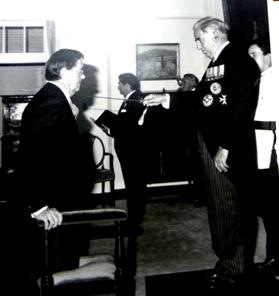
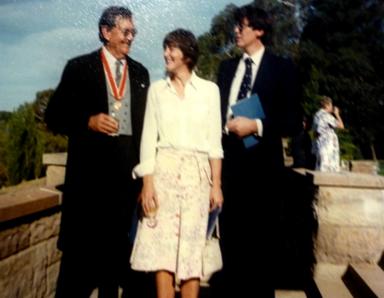
RECEIVING HIS KNIGHTHOOD AND CELEBRATING WITH DAUGHTER SUSAN AND SON JAMES
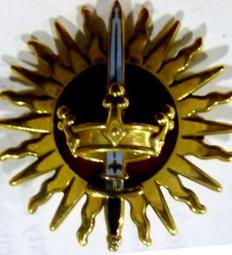
A LADY’S BROOCH AWARDED WITH THE KNIGHTHOOD TO HIS WIFE MARY.
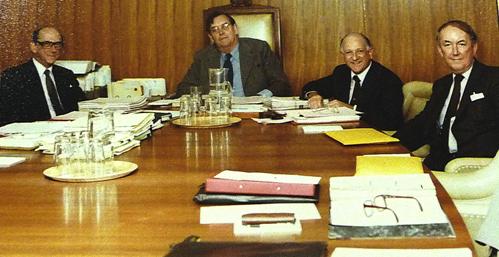
CHAIRING A MEETING OF THE FEDERAL COUNCIL OF THE AMA.
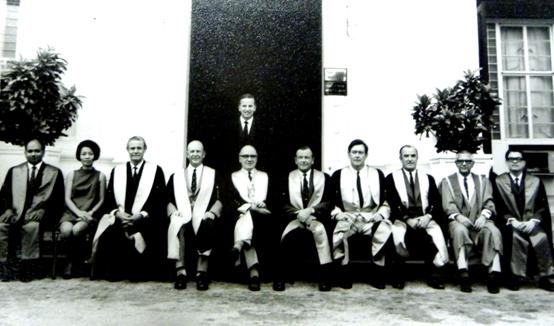
PHOTOGRAPH OF THE COLLEGE OF EXAMINERS
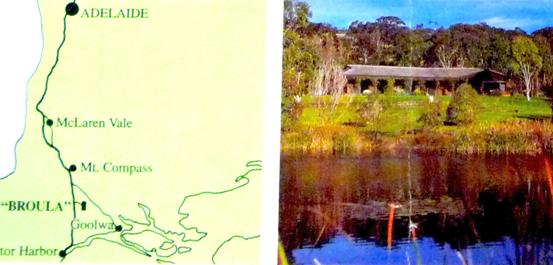
AFTER RETIREMENT SIR RUPERT AND HIS WIFE MOVED TO THEIR PROPERTY AT MT. COMPASS. THEY DESIGNED THE HOUSE AND THE PICTURE SHOWS THE IDYLLIC SURROUNDS. THEY NAMED THE PROPERTY BROULA
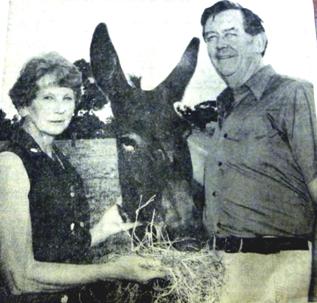
SIR RUPERT AND HIS WIFE MARY AT BROULA
Recollections of Dr Ross Johnson
Ross Johnson was a Senior Surgeon at the Queen Elizabeth Hospital and joined Sir Rupert’s clinic in 1970. The following are his recollections.
"Bob Magarey was unwittingly my mentor both during my medical student days and also throughout my surgical career.
I happened to be attached to his surgical outpatient clinic in my fifth year and considered myself indeed fortunate as he was justifiably known as the ‘Prince of Tutors.’ He was well organised and loved teaching. What he taught at that time still sticks with me. He would have been 42 in that year, 1956, and was a Clinical Assistant at the RAH, a dogs body job in those years as Clinical Assistants at the RAH had no operating rights but put their outpatients on the operating lists of whomsoever was their designated head of unit. The Senior Honorary Surgeons did not deign to attend surgical outpatients.
Around that time Bob had had a melanoma diagnosed and operated upon. It was somewhere on his trunk and he elected to have block dissections of both axillae and both groins, formidable procedures for what could be a lethal condition. He never had a recurrence. I remember melanoma was his favourite teaching topic at the time and what he taught stuck.
In our sixth year he was elected President of the Medical Students’ Society. For some reason I was elected to organise the annual Medical Students Dinner at the Myer Apollo Dining Room, time I could ill afford, and was answerable to the President so I formed quite a rapport with Bob. Thanks to his sound advice the dinner went off well.
My next contact with Bob was in 1965 when he was one of three Senior Honorary Surgeons at the recently opened Queen Elizabeth Hospital at Woodville. I wrote to him from England after passing my FRCS hoping he would remember me and asking him for a job at TQEH. His reply was warm and friendly and a job was offered by Doug Carmen, the Superintendent, solely on his recommendation. He did not bother to check any of my references. I rather suspect I was given the job as my wife had nursed his patients at the Memorial Hospital, a fact which I was careful to point out in my letter!
In 1967 Bob was Chairmen of the Court of Examiners of the Australasian College and whom should I have as an examiner but the Chairman himself. Yes, of course there was a gall bladder patient, and yes, of course the question of his famous window operation came up.
‘Don’t be shy Ross, so and so (his fellow examiner) would love to hear all about biliary fenestration,’ he said putting his arm across my shoulders. It was a godsend as I was not travelling at all well at that stage of the exam.
In the 1970s I joined Bob on his clinic with Trevor Pickering and we three had a very pleasant association for some years up until he retired in the 80s. His contribution to the medical profession during this time was amazing and he showed great leadership and wisdom in all the many offices he held. He led the QEH Medical Staff in its transition from being Honorary based to salary based. He always did his homework thoroughly and we were all the benefactors of his skilful negotiations with the government bureaucrats of the day.
Bob served his profession with great distinction, Chairman of the QEH Staff Society, President of the AMA of SA, Federal President of the AMA, Surgical College Councillor and Chairman of the Court of Examiners of the Surgical College to name a few. His Knighthood in 1880 was richly deserved and humbly accepted.
Bob was generous to a fault and entertained his whole unit on a regular basis both at his home in Medindie and down on his farm at Mt Compass where he would hitch up the tractor to a hay wagon and take our children for rides. He gave of himself to his colleagues and certainly Trevor Pickering and I have very fond memories of the man himself.
Bob rarely talked of his WWII exploits and his experiences on the Kokoda Trail nor did he tell us that he had been mentioned in despatches in the Syrian campaign. Various books have described his war exploits, ‘Retreat from Kokoda,’ ‘No Memory for Pain’ and ‘Those ragged Bloody Heroes.’
How sad it was for Bob and his family and all of us when his beloved Mary died in the late 80s. He had developed dementia before her demise and I visited Bob at the College Park Nursing Home shortly before his death in 1990 at the age of 76. He was still at that stage a strong fine looking man, upright, and with a full head of dark hair, well dressed in a tweed jacked and proudly wearing his college tie. He looked so out of place amid the crumbling humanity around him. We had a good chat about old times and then said our farewells."
-o0o-